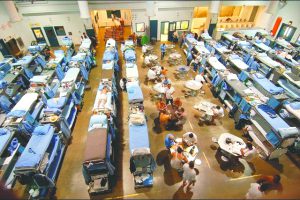BY Estephania Baez
There are more people incarcerated in the United States than anywhere else in the world. According to Department of justice data, more than 2.2 million people are currently behind bars, and 25% of all the inmates in the world are housed in the U.S…
However, this has not always been the case. The inmate population has risen in the last two decades, starting during the Clinton Administration, when the percentage increased by as much as forty-five percent in an effort by the then-President to rid U.S. city streets of crime. Expert analysists, on the other hand, feel that it was not just a campaign to curb violence, but rather was motivated by money, since it coincided with the U.S. government beginning to subcontract the housing of inmates to the Correctional Corporation of America (CCA).
As a result, private prisons were set up in vulnerable communities and thousands more in counties throughout the U.S., all funded with taxpayer dollars.
The strategy eventually backfired. Just this past November, President Barack Obama stated that every year $80 billion are spent to keep people incarcerated, in spite of the fact that many of them are there for lesser crimes and are serving sentences for non-felony offenses.
“I believe we can disrupt the pipeline from underfunded schools to overcrowded jails. I believe we can address the disparities in the application of criminal justice, from arrest rates to sentencing to incarceration… we know that having millions of people in the criminal justice system, without any ability to find a job after release, is unsustainable. It’s bad for communities and it’s bad for our economy”, expressed the President, for whom prison reform has become a top priority.
Due to this issues, towards the end of 2015 the U.S. Department of Justice began to release inmates, starting with 6,000 prisoners in November, in addition to 1,700 foreigners who were released to Immigration authorities which will in turn decide whether these undocumented immigrants who entered illegally would be deported or held in U.S. Detention Centers to serve out their sentences.
This inmate release is follows a decision made by the U.S. Sentencing Commission aimed at reducing punishment for crimes related to the possession, use, and sale of drugs. The individuals set free had already served eighty percent of their sentence at the time of release.
In addition, as part of the prison reform projects the White House supported a proposal that would make it mandatory for judges to impose 10+ year sentences for non-violent drug offenses.
Latinos and African-Americans make up the majority of inmates. In the case of Hispanics, the sentences are usually related to immigration felonies, such as entering the U.S. illegally or helping someone else do it. African-Americans, on the other hand, face sentences for lesser violent crimes such as theft or robbery without the use of a firearm.
During the 80’s, more than forty thousand people were imprisoned in the U.S. for drug-related offenses; that number has jumped to over 500,000 today.
Harsher sentences are also an issue. As an example, a burglary carries a sixteen-month sentence in the U.S., while the average in Canada and the UK is five months. Furthermore, the increase in violent crime in the U.S. can be attributed to easy access to firearms, another topic of debate on the President’s table and for which no solutions have been reached.